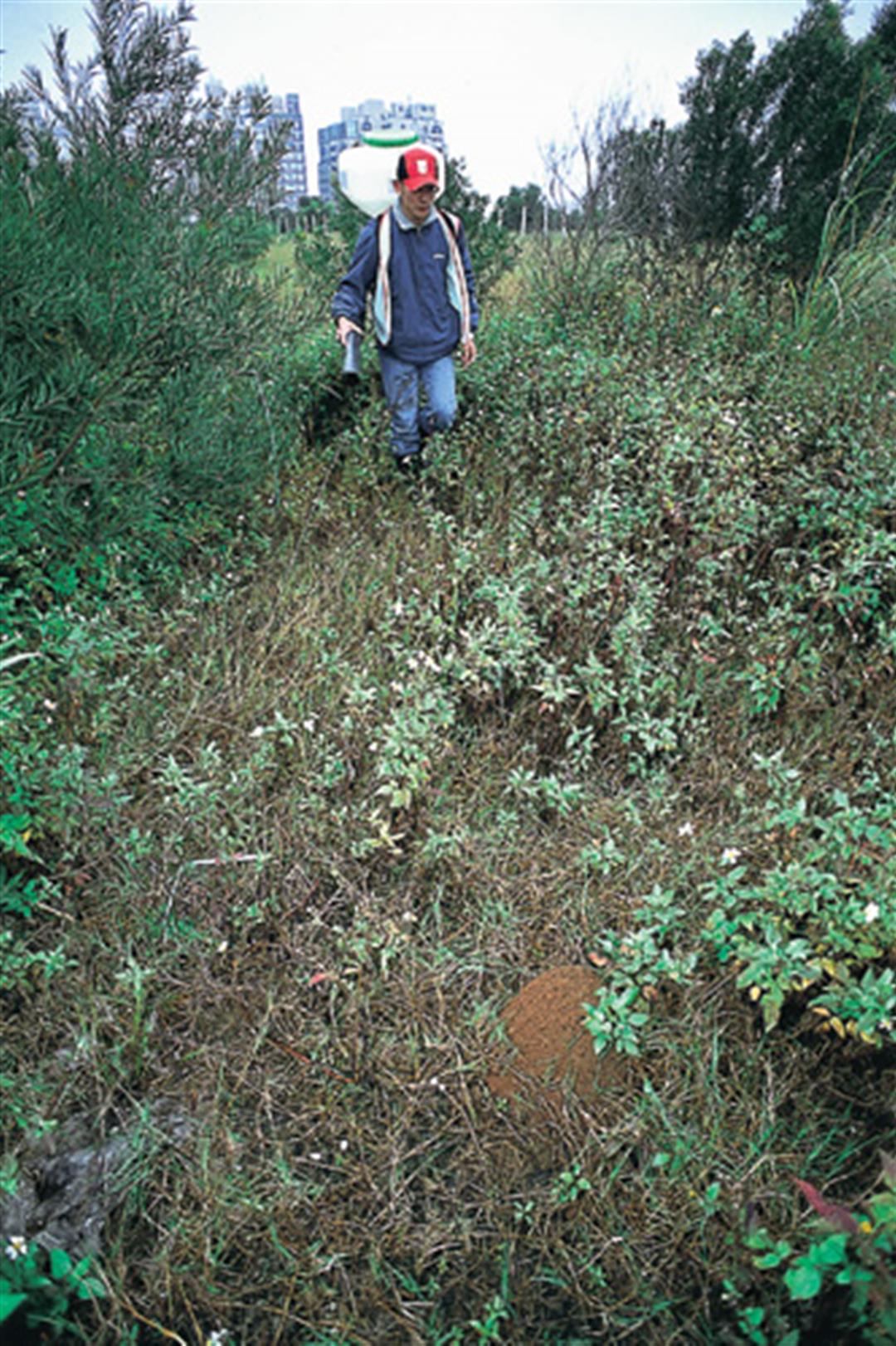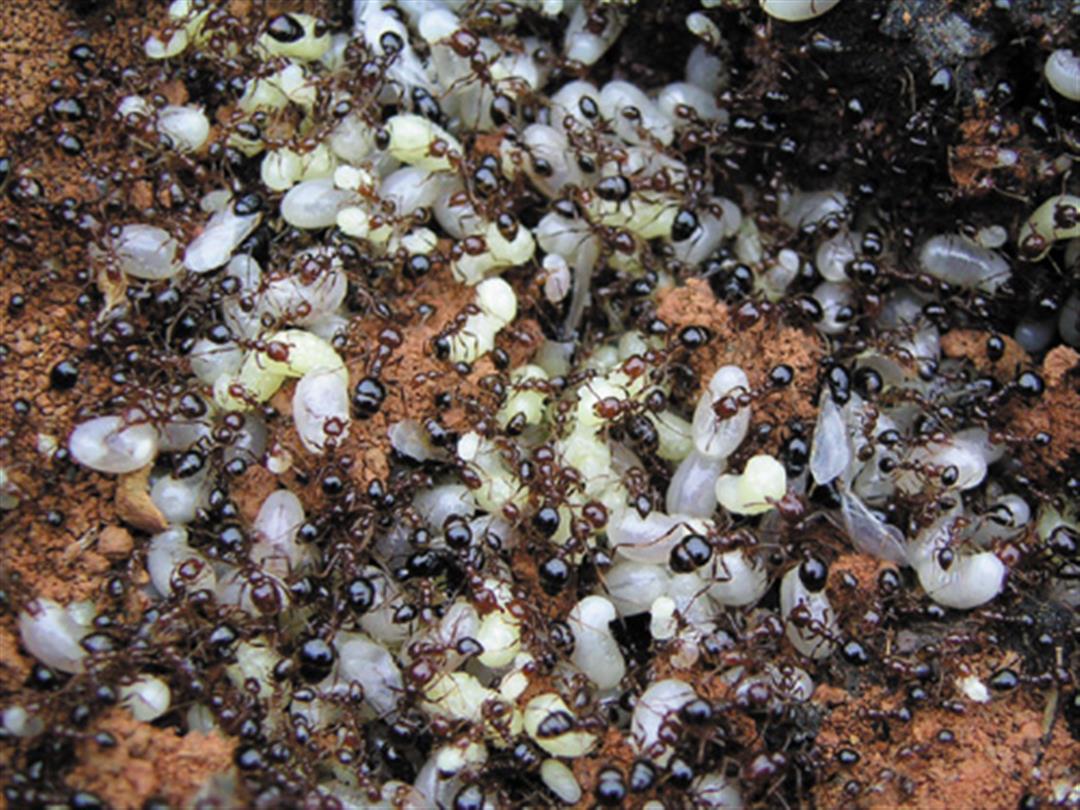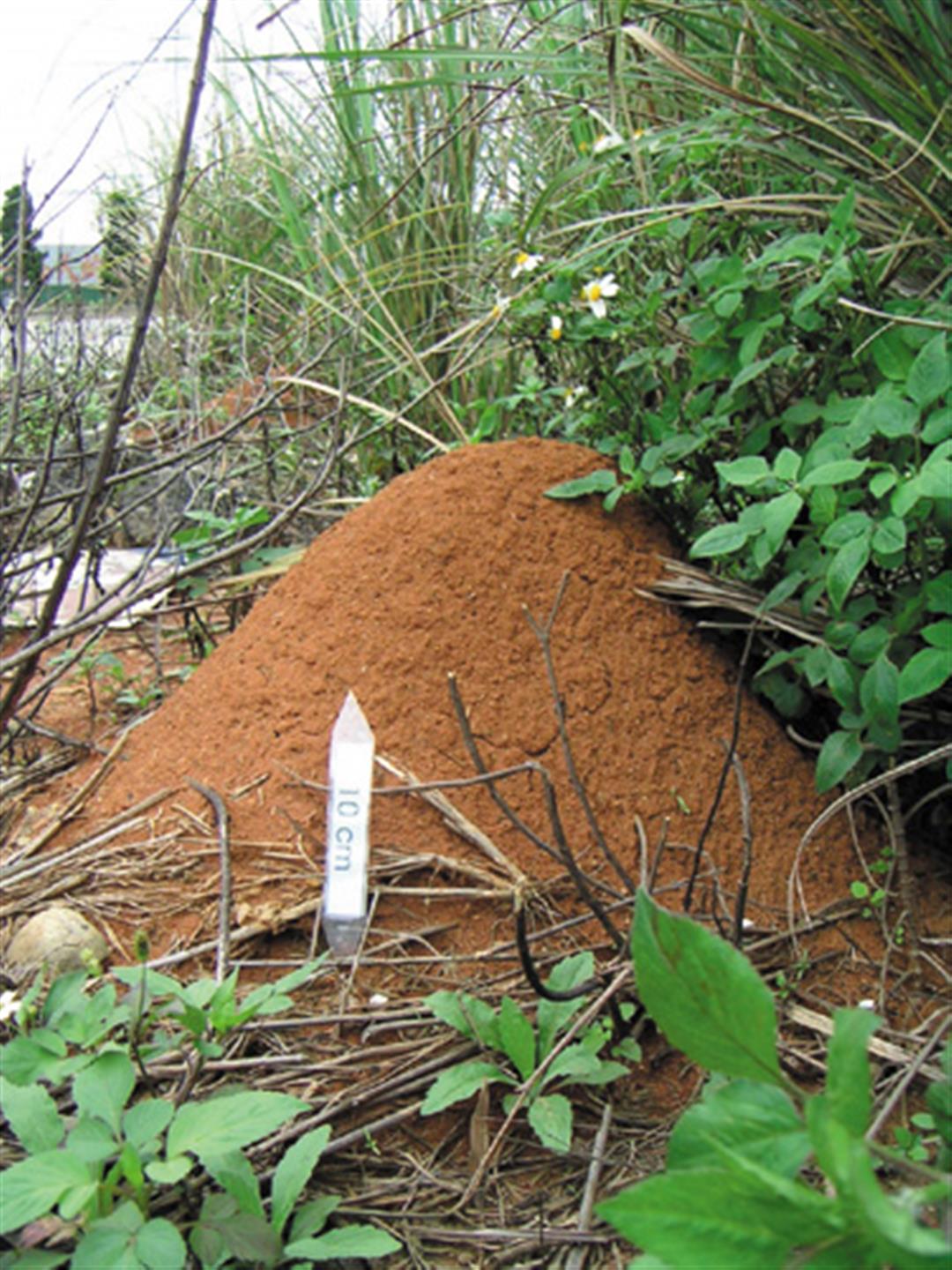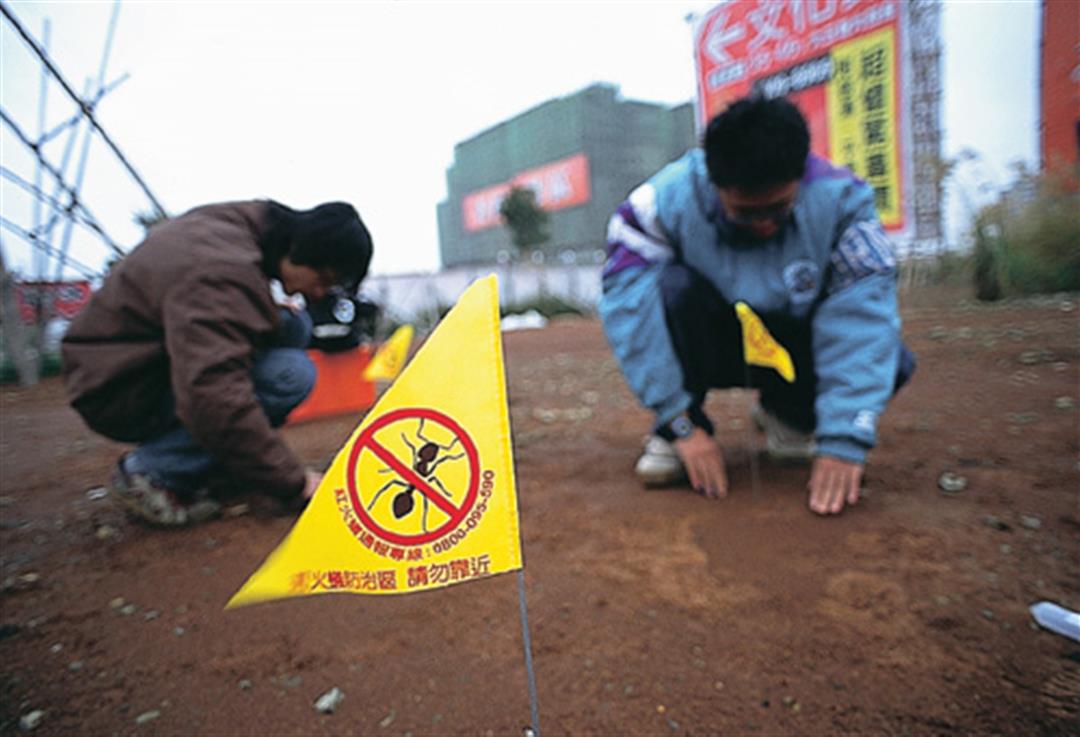
In late 2004, an invasion of "red imported fire ants" caused alarm in Taiwan. One after another, warning tapes were placed around farms, schools, and roads in 13 townships in both northern and southern Taiwan--mainly in Taoyuan and Chiayi--thus putting the tiny ants in the media spotlight. After a summer and winter have passed, news of the "ant plague" now appears but rarely. But will the troublesome ants, which are not native to Taiwan, really be gotten rid of so easily? What is the situation now with the invading fire ants?
In 2003, after many Taoyuan farmers were stung by unknown ants, the wounds burned painfully and developed blisters. Applying medication or requesting assistance from agricultural authorities proved to be of no help. With the farmers' work routine affected, the expertise of the Department of Entomology at National Taiwan University was called upon. After examining specimens, it was determined that the ants were a variety of fire ants that have plagued the United States for more than 70 years and that had crossed the ocean to arrive in Taiwan.
This discovery was significant, as America has suffered greatly from the ant infestation, which affects 10 million hectares of land. The infestation results in economic losses amounting to more than US$5 billion per year in more than ten southern states. Even more worrisome is the fact that around 2% of the people stung by red imported fire ants die from shock precipitated by an allergic reaction. Although the US is striving mightily to control the infestation, the ants have already established themselves, making it difficult to eliminate them completely. In 2001, red imported fire ants began appearing Australia. With America's experience as a warning, Australia spent enormous sums each year, making a national effort to prevent the ant infestation from spreading.
Ant expert Lin Chung-chi surmises that red imported fire ants may have been transported to Taiwan in the mud on the underside of aircraft cargo containers. Therefore, Taoyuan County, where Taiwan's largest international airport is located, was the site of the initial ant infestation, which remained undiscovered for one or two years as its spread from town to town.

When the red imported fire ant nest is breached, swarms of worker ants take up the egg-like larvae and make ready to escape.
A marauding army
Red imported fire ants originally inhabited South America's Parana River basin. In their native habitat, the ants live as a single-queen colony, with each colony consisting of 50,000 to 240,000 ants. They do not have a fixed time for their mating flight (when they fly to great heights to mate). If the colony is mature, a new virgin queen may be produced at any time during the year. After the mating flight and the death of the male ant, the queen flies to a new site as far as five kilometers away to establish a new home where she will lay eggs. As the colony matures over a period of six months, it will build up an anthill from ten to 30 centimeters in diameter.
Besides other insects and birds, another natural enemy of ants is in fact other ants, because they compete for food. After red imported fire ants migrated to other countries, their social organization changed to multiple-queen colonies. In addition, because they had no natural enemies in their adopted habitats, they used large numbers to achieve dominance, occupying territory with a rapidity like that of a marauding army, annihilating native ant colonies one by one.
Red imported fire ants are omnivorous creatures that eat virtually anything, though their diet consists mostly of plant seeds, fruit, and seedlings. They also supplement their diet with earthworms or other insects living in the soil, as a result of which crops in areas infested with the fire ants suffer heavy damage. The ants may even prey on birds or insect larvae, resulting in reduced numbers of species and thereby affecting the local ecology.
Besides damage to the natural world, fire ants also pose a serious safety threat to humans. Although ants do not generally attack people without provocation, if an ant colony is disturbed by, for example, a farmer harvesting crops or people accidentally coming into contact with one, large numbers of ants may attack the intruder. Because a fire ant's stinger does not have a barb, it will not become detached after the ant delivers the sting, unlike those of other types of ants. A fire ant may thus pierce the skin of its victims with its stinger seven or eight times in succession, injecting large amounts of an acidic toxin that causes painful swelling and blistering. The toxin may also trigger allergic reactions that in serious cases can affect the entire body, and even cause death from shock.

A mature red imported fire ant colony's anthill usually stands about 30 centimeters tall, making it obviously larger than those of other ants.
A battle of wits
Wu Wen-jer, director of the National Red Imported Fire Ant Control Center (NRIFACC) and professor of entomology at National Taiwan University (NTU), states that there are currently two approaches to fighting fire ants. The first is the "two-stage" method, the first stage being to put out poisoned bait during the spring and autumn--the two seasons when ants feed most actively--and allow the ants to take the bait back to their nest. Because ants feed each other, the entire nest of ants will be poisoned. Two or three weeks later, physical means such as contact pesticides, fire, or hot water can be used to destroy individual ant nests. If the first stage is not performed, and an attempt is made to kill ants on contact, the queen and some drones hidden deep with the nest will make a quick escape only to establish another colony at a new site, leading to a scenario of "the more are killed, the more there are."
For infestations covering large areas, growth regulators are used. When larvae ingest such a substance after it is brought back by worker ants, they die en masse. The eggs laid by a queen ant that has ingested the toxin will not be able to hatch, and the colony eventually dies out. However, whatever method is used, any area that has been infested by fire ants must be monitored over an extended period to prevent fire ants from escaping or re-establishing themselves elsewhere.
After more than a year of fighting the fire ants, what is the situation in Taiwan?
Looking at the scenario that has received the most attention--the infestation of school campuses by the fire ants--"The number of affected schools appears to be gradually trending upwards since the beginning of 2005," says Chen Chih-chieh, executive secretary in charge of fire ant prevention for the Ministry of Education. The number of schools on the watch list has already risen to more than 100, three of which may be able to be removed from the list in 2006, and overall, the situation seems to be under control.

For more than a year, the National Red Imported Fire Ant Control Center has been monitoring the population levels of the ants in afflicted areas. Although the ants have not spread, much work remains to be done before they can be banished from Taiwan.
Spring breezes
"The fact that the ants don't seem to have spread outside the originally affected areas is encouraging," says Shih Cheng-jen, executive director of the NRIFACC and NTU professor of entomology. He adds that as of the beginning of 2006, afflicted areas had been kept at around 10,000 hectares. However, he also admits that the situation within those areas has not markedly improved, because the ants reproduce too quickly. Workers exterminate half the population of ants, only to see the population immediately increase again by 30%.
Shih concludes that a lack of efficient coordination among government authorities is a key factor behind the lack of complete success. Currently, the government's control regime relies on local administrative units of central agencies to take charge within their jurisdictions, while the Council of Agriculture's Bureau of Animal and Plant Health Inspection and Quarantine handles coordination. Local governments are responsible for actual pesticide application, while the NRIFACC serves as a center for managing resources and technology, taking charge of keeping the public informed, measuring fire ant population levels in affected areas, and monitoring whether infestation is spreading to outside areas.
Because the city and county governments are only in charge of exterminating ants in farming areas, while fire ants have infested locations outside such areas, possibly even invading places such as industrial parks, military facilities, school campuses, roads and railways, parks and traffic islands, the current approach of distributing control tasks among a large number of organizations has led to a situation where "whenever fire ants fly past an area, the agency responsible for control measures changes!" says Shih. He adds that these local administrative units are overseen by the Ministry of Economic Affairs, the Ministry of National Defense, the Ministry of Education, the Ministry of Transportation and Communications, and the Environmental Protection Administration--putting them outside the authority of local governments, and greatly compromising the efficiency of prevention efforts.
Presently, though the NRFIACC has created a reporting system that allows immediate handling of newly discovered infestations, the approach remains fundamentally passive. To achieve a more proactive approach requires thorough long-term monitoring.
The NRFACC's Wu uses the severely affected Taoyuan, Taipei, and Chiayi Counties to illustrate what is needed. These areas should regularly perform full-scale surveys, including locations where people do not normally venture, such as highway embankments and vacant lots that can easily become safe havens for fire ants to hide themselves and grow. However, the center has been constituted with only seven people and an annual budget of just NT$10 million--grossly deficient in terms of both manpower and financial resources for handling reported infestations, responding to queries, and managing the website, while allowing only two persons to actually perform surveys.
Lin Chung-chi cites Australia's efforts to fight fire ants. The Australians placed administrative functions, financial operations, research and development, and pesticide application all under the authority of its Fire Ant Control Centre, which was established with a staff of 600 and a three-year budget totaling around NT$5 billion. When the fire ants appear at any location, the center immediately dispatches personnel to handle it. Regular testing and monitoring is also performed, and the center's operations are given an extremely high priority within the government, with a ministry official put in charge.
Wu points out that because the government ministries in Taiwan overseeing the efforts to counter the fire ant lack entomologists on their staffs, and must rely on the Bureau of Animal and Plant Health Inspection and Quarantine for coordination, "too many ministries are involved, and it's not surprising that the Council of Agriculture is exhausted by the effort." He calls attention to the fact that the anti-fire ant campaign reveals a further complication in countering destructive non-native species: besides annihilating already discovered fire ants, preventing migrations and keeping more fire ants from entering the country are also important parts of the effort. In order to eliminate the threat during the "ten golden years" when it most achievable, these elements require that the effort be given higher priority so that the fire ants can be completely eradicated. Otherwise, fire ants may follow the lead of other non-native species that have established a firm foothold in Taiwan, like the apple snail, which has caused nearly NT$10 billion of damage to Taiwan's agricultural industry, and bittervine (Mikania micrantha) which has devastated large swathes of woodland.




@List.jpg?w=522&h=410&mode=crop&format=webp&quality=80)


